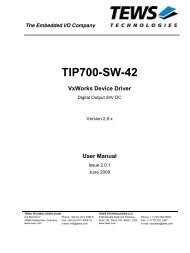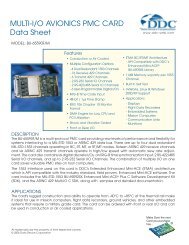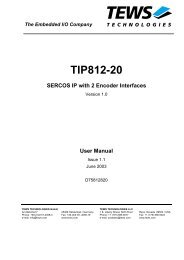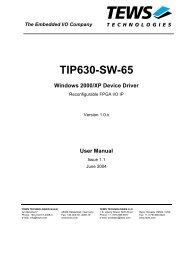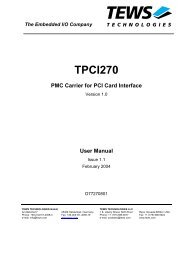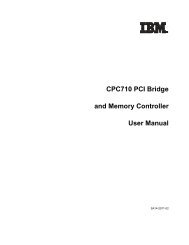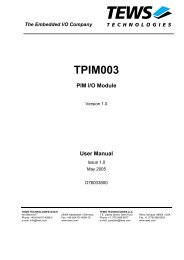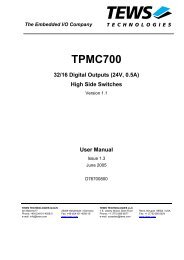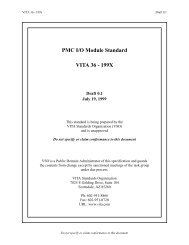MicroTCA TM - PICMG
MicroTCA TM - PICMG
MicroTCA TM - PICMG
You also want an ePaper? Increase the reach of your titles
YUMPU automatically turns print PDFs into web optimized ePapers that Google loves.
Not Intended for Design - Do not Claim Compliance<br />
Figure 18 could represent a Module that comprises the entire Power Subsystem, or it could be one of up to four such<br />
Modules used in a redundant configuration. The Module receives its energy from up to two DC feeds and provides<br />
power independently to up to twelve AdvancedMCs, up to two MCHs, and up to two Cooling Units. This Module can<br />
be used in applications where payload and Management Power are provided with N+1 redundancy, where N=1, 2, or<br />
3. In addition, this Module can be used to provide non-redundant payload and Management Power (i.e. the special<br />
case of N+0).<br />
Power sources<br />
<strong>MicroTCA</strong> systems may be powered from a variety of sources. Development of the specification and the<br />
architectures herein, have given consideration to Power Modules with the following sources of power (all voltages<br />
levels listed are nominal):<br />
• –48 V battery plants<br />
• –60 V battery plants<br />
• +24 V battery plants<br />
• 100 V AC mains power<br />
• 120 V AC mains power<br />
• 230 V AC mains power<br />
To support these differing power sources and to support modular implementations, a number of different Power<br />
Module types are anticipated:<br />
• Negative DC voltage Modules—this type accepts either –48 VDC or –60 VDC feeds to power the system<br />
• Positive DC voltage Modules—this type accepts +24 VDC to power the system<br />
• AC-powered Modules—this type of Module accepts 100 V, 120 V or 230 V AC mains to power the<br />
system<br />
And within these Module types, subtypes may emerge, depending on the level of optimization required. For example,<br />
further optimization of the negative DC voltage Module may result from limiting its input to only –48 VDC battery<br />
plants.<br />
System power-up<br />
Power management of the <strong>MicroTCA</strong> Carrier has two distinct stages.<br />
• The Early Power stage starts from the moment a source of energy is made available to the PM and ends<br />
when the Carrier Manager assumes control of power management tasks.<br />
• The Normal Power stage starts once a Carrier Manager is elected by one or more powered and initialized<br />
MCHs.<br />
Autonomous mode may also be used during system maintenance, for example, where all MCHs are removed from a<br />
system but the remaining load modules must continue to operate undisturbed.<br />
<strong>PICMG</strong>® MTCA.0 Short Form Specification, September 21 st , 2006 27 of 34




